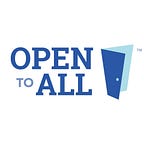Disability Etiquette and Inclusion in the Workplace
Guest blog post by Nonprofit Advisory Council member Disability:IN, a nonprofit that empowers businesses to achieve disability inclusion and equality.
Like other identity markers, disability comes with a range of lived experiences that varies both in type and appearance. From physical disabilities to mental health, disabilities run the gamut, often in ways that we cannot see. One in five Americans lives with a disability; 75% of these disabilities are non-apparent. Even then, no two people with the same disability will have the exact same experience or needs.
Because of this range in disabilities, we should approach interactions with a disabled colleague from a place of openness and trust, not a place of presumption. Trust that they will tell you what they need if you ask. Trust that they are in control of any aids or guide animals. Trust that whomever you’re speaking to, especially if it is someone who may need an interpreter, prefers to be addressed directly. By recognizing one another’s autonomy, we can build relationships that hinge on respect and mutuality rather than preconceived notions.
Though we may never be privy to the specifics of a person’s disability, a baseline of knowledge and best practices can make conversations around work distribution, recruitment, and even watercooler talk easier to approach. Asking a person how you can support them will always be an important first step, but a toolkit can be a great supplement. The list below contains a selection of disabilities and associated best practices. It is by no means exhaustive, and an individual’s preference should always come first.
General Dos and Don’ts:
- Relax and enjoy getting to know your colleagues or guests as people and as professionals.
- Ask before you provide assistance.
- Do not assume that a person with an apparent disability needs assistance; offering assistance in broad terms such as, “Let me know if you need anything,” opens the door without assumptions of inability.
- Think in terms of “Disability Pride” language, using powerful words such as: “wheelchair user,” as opposed to “confined to a wheelchair” or “wheelchair person.”
Individuals with Mobility Disabilities:
- Do not touch a person’s mobility equipment.
- Be sensitive about physical contact in consideration of things like possible pain or balance.
- Always direct your conversation that is meant for the person with a disability to them and not to their personal assistant, interpreter, companion, or colleague.
- If convenient and natural, put yourself at the person’s eye level when engaging in a conversation; rather than kneeling, pull up a chair.
Individuals who are Blind or Low Vision:
- Identify yourself when approaching the person or entering an ongoing conversation; announce when you leave the conversation or the room.
- When serving as a sighted guide, offer your arm or shoulder rather than grabbing the person’s arm or pushing the person from the back.
- Describe the directions and obstacles when serving as a sighted guide.
- Resist the temptation to pet or talk to a guide or service animal; ask the person first.
Individuals who are Deaf or Hard of Hearing:
- Gain the person’s attention before starting a conversation (e.g., tap the person gently on the shoulder or arm or by a hand signal).
- If the individual uses a sign language interpreter, speak directly to the person, not the interpreter; keep your eyes on the individual and not on the interpreter.
- Face the person, speak in normal tones, and avoid the instinct to shout, as it doesn’t help.
Often, our fear of saying or doing the wrong thing supersedes our desire to connect. However, communication is collaborative. When we speak up, we invite one another to create a language and culture that respects everyone. A community is a collection of individuals, not a monolith. By carefully considering ideas and lived experience, we increase our ability to innovate, improve productivity and morale, and open the door for an environment that celebrates our differences, rather than ignores or minimizes them. Everyone deserves the opportunity to be accepted as their true selves; by continuing these conversations, overcoming our discomfort, and sincerely engaging with one another, we get a bit closer to that reality.
To learn more about Disability:IN and their resources, check out the following:
· Disability:IN Resources
· Disability:IN Disability Equality Index Best Practices
· Disability:IN 2021 Disability Equality Index Report
· Disability:IN Roadmap to Mental Wellness in the Workplace
· Disability:IN Creating Accessible Zoom Meetings
· Disability:IN Best Practices for Accessible, Inclusive Communications
· Disability:IN & Google Disability Fundamentals Training for Managers
· Disability:IN COVID Response Series
